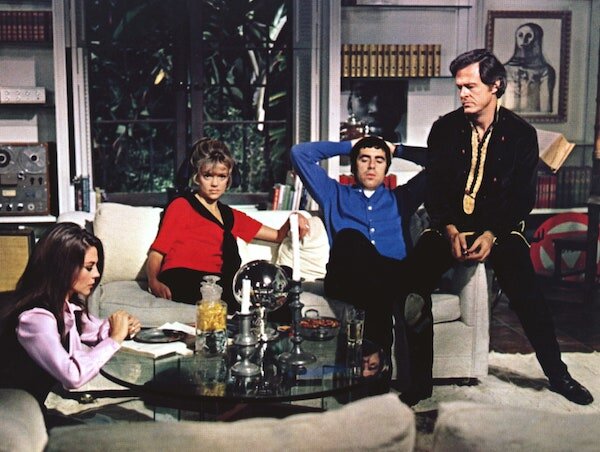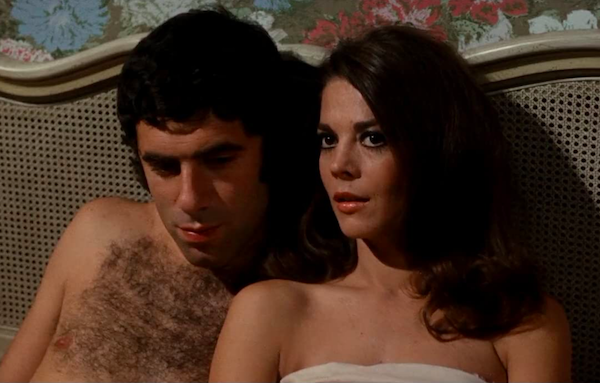America’s sexual revolution of the 1960s saw the advent of the oral contraceptive and the arrival of Paul Mazursky’s directorial debut – a film celebrating the autonomy of intercourse, whether it happens or not. And some 60 years on, in a touch-starved year during a global pandemic, Saffron Maeve reflects on why the film’s brilliance still endures.
“That's all that's on their minds, is sex. Sex, sex, sex, and sex. If it's on your mind all the time it can't be a very good thing, can it? I mean, shouldn't it just happen? It used to just happen!”
The advent of the oral contraceptive (“the pill”) marked the beginning of America’s sexual revolution. Enovid—a combination of mestranol and norethynodrel—was approved by the FDA for contraceptive use in 1960. This proved not only to be a highly marketable product, but a major step forward for reproductive freedom. Young women’s college attendance spiked, as fewer ran the risk of unwanted pregnancies, and peoples’ perception of sex drastically began to change. There were some ethical issues raised, concerning the unnecessarily high hormone doses in these pills that were later remedied, but on the whole, Enovid was considered a useful invention.
But as one could reasonably expect of that time, this pill was a hugely controversial issue that state laws spent years policing before it would become widely accessible. In Connecticut and Massachusetts, for instance, Enovid was illegal to distribute, resulting in US Supreme Court cases like Griswold v. Connecticut (1965) and Eisenstadt v. Baird (1972). Both of these cases ruled against the state and favoured birth control access, with the former setting an important legal precedent for Roe v. Wade eight years later.
Then the Catholic Church, by way of Pope Paul VI, publicly denounced the use of artificial contraception in an encyclical titled Humanae Vitae (‘Of Human Life’) in 1968. Many considered this a strange and intrusive use of papal authority, while others wholeheartedly agreed with the sentiment. Suffice it to say, it was a heated topic both in and outside courtrooms and the Vatican.
But what does any of this have to do with the movie? Or orgies?
Well, this new wave of body autonomy coupled with American disillusionment in the wake of JFK’s assassination and the Vietnam War prompted mass social revolution. This was the era of the Civil Rights Movement, Stonewall Riots, and rampant counterculture. As can only be expected, this radical upheaval of social, political, and judicial norms manifested its way into American filmmaking, resulting in films like Zabriskie Point, Easy Rider, and even The Graduate.
Films of this era pushed back against both the formal and narrative elements of classical Hollywood filmmaking. With the dissolution of the Production Code and the youth’s investment in counterculture came increased depictions of sex onscreen. Several films concerned themselves entirely with sex: the good, the bad, and the profane. Many of these works existed solely for that epoch, and would likely have little impact in today’s relatively sex-positive times.
Cinema of the 1970s built upon this, with invocations of its own political happenings: Watergate, Roe v. Wade, the conclusion of America’s longest war, et cetera. But by the end of the decade, the Enovid-induced hysteria had subsided and sex on screen was ordinary, if not expected. This decade was past the toe-dipping stage of onscreen sexual exploration; likely because of a combined political effort to destigmatize sex and drive profits and the trickling cultural impact of the sixties’ resistance, drugs, and flower power.
Somewhere in between the most politically-charged years of the 1960s and the more so unshackled filmic attitudes of the 1970s lies Paul Mazursky’s ambitious directorial debut, Bob & Carol & Ted & Alice. Set and released in 1969 and nominated for four Academy Awards – a feat in general, but especially for this subject matter – the film satirises the sexual revolution in a way that doesn’t feel antagonistic. Here, levity serves to address broader cultural concerns and every scene is rife with sexual tension that gradually unpacks itself until its climax: an orgy. Sort of.
The film begins with the two titular couples: Ted and Alice (Elliott Gould and Dyan Cannon), who are posited as the quintessential squares – conservative, happily married, and unconcerned with the growing sexual marketplace of the 1960s – and Bob and Carol (Robert Culp and Natalie Wood), who signify an immense cultural departure from the 1950s. The two couples’ respective ideologies mingle and merge throughout, allowing all four to explore their sexual desires and conceptions of marriage with little consequence.
After an Esalen-esque weekend retreat, Bob and Carol decide to be completely open with one another; they share their feelings constantly and verbalise their sexual desires when apt. Ted and Alice are both taken aback and mildly intrigued by this sudden change in their friends. Soon after, it is revealed that both Bob and Carol are both having extramarital affairs. (Neither of them are engaging in anything “serious”, just casual sex.) This information proves much more shocking to their friends than it does to one another.
Reviling in their newfound candour, Bob and Carol understand and respect each other’s decisions – almost too much. They speak very little about their infidelity and when they do, their discussion is characterised by a startling indifference. The concept of a binding marriage begins to dissolve before the viewers’ eyes with a speed and informality that feels entirely unfamiliar. It is here that Mazursky unearths the fallacies of non-monogamous relationships, suggesting that these characters are handling their situation unnaturally. Why aren’t they screaming? How can they be so calm?
While the intent here may be to mock, what strikes me most when I rewatch this film is how rational some of these exchanges actually are. Bob & Carol & Ted & Alice handles polyamory with a delicacy and maturity that feels uncharacteristic of its time. For a movie made 51 years ago, the depth and validity of these conversations were wholly progressive, even by today’s standards. Mazursky’s assertion, that while monogamy may be the standard, it isn’t everyone’s de facto preference, was an audacious move.
In the final act, where tension is at its boiling point, viewers are met with the lines we were waiting for the entire time:
“Well, what do you feel like doing?”
“I feel like doing what we came up here to do.”
“And what is that?”
“Orgy! Have an orgy! Orgy! Orgy! Orgy! Orgy!”
And then, they don’t. They get undressed, climb under the covers, swap partners for a brief moment, and then stop. Silently, they stand up and make their way downstairs; Bob and Carol’s hands interlocked followed by Ted and Alice’s, just the same. Some found this ending to be, quite literally, an anticlimactic rejection of the era’s promiscuity. But I don’t see Bob & Carol & Ted & Alice as a cautionary tale, hellbent on condemning sexual liberation; it neither vilifies nor endorses free love. It pokes fun at it, but its central thesis isn’t as grim as one may believe.
At its core, the film tells a story about adapting to rapidly changing times, and the confusion and senselessness that arises within them. Nobody is right. No one character’s perspective is privileged over another’s. Ted and Alice adamantly clung to a dying conservatism that limited their relationship, and was only rectified by the prospect of sexual exploration. Conversely, Bob and Carol dove headfirst into the free spirit of the times, but ultimately decided to disengage when they felt uncomfortable. While the four characters make the decision to refrain from group sex, it is the openness to even consider it that marks a shift in the American public’s attitude towards intimacy and monogamy.
And still, the film’s “orgy” was advertised to no end. The original posters and marketing all featured the quintessential photo of the four characters in bed with the accompanying tagline: “Consider the possibilities”. The erotic possibilities were left up to prospective viewers – ideally swarms of horny American youths flocking to the box office, eager to see if what’s on screen is on par with their imagination. Presumably, it’s not. Bob & Carol & Ted & Alice is a film about a sex scene that never happens, but we all discuss it at length as though it had.
Here, the absence of intercourse is more significant than its presence. The palpable sexual tension that had been brewing throughout would be sorely lost with the physical act of sex. Had the four gone through with it, the film might have captured the brazen attitude of the 1960s, but with little potential to translate to today’s youth. Instead, this tension dissipates in a way that is so ambiguous, you can’t quite declare that it’s gone. Then, with a startling string of onlookers staring into the camera before the screen cuts to black, we understand that this is bigger than Enovid and experimentation – it’s about connection.
One of the greatest things to be born into the 1960s – Stanley Tucci and The Zombies’ Begin Here notwithstanding – Bob & Carol & Ted & Alice broaches our overwhelming desire to connect head-on. And while sex can undoubtedly incite that connection, it doesn’t necessarily have to; have an orgy, don’t have an orgy, it’s up to you. This emphasis on autonomy allowed the film to age gracefully enough to find a home among today’s audiences. So now, in a bleak, touch-starved 2020, we can revel in our collective longing to be seen and understood by others. Both in and outside of bedsheets.
Saffron Maeve (@saffronmaeve) is a film writer studying English and Cinema at the University of Toronto, with aspirations to have her own Criterion closet video. When she’s not writing, she can be found rewatching The Goonies and pestering everyone she knows to do the same.



